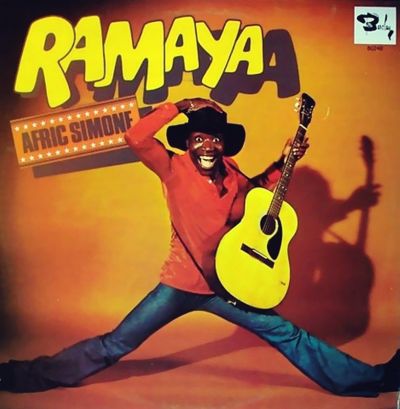SONGWRITER
Ramaya: the tonal workings of the famous African disco hit

Ramaya LP cover
Ramaya is the best-known song of Mozambican street singer Afric Simone whose career took off in 1970s Europe when disco popularity skyrocketed, leading to scores of disco tracks topping the global charts.
Originally released as the opener of Afric Simone's 1975 debut album Ramaya, the song was later issued as a single which entered the top five charts of several countries including Italy, the Netherlands, Belgium, France, and Sweden.
Written in a mixture of Swahili and other languages, the song is dedicated to a beautiful girl named Ramaya to whom the enamoured narrator bids farewell, wishing her good luck. Simone allegedly said of his choice to sing many of his songs using such a bizarre linguistic concoction: "Language can't be a problem if the rhythm, the music and the sound are right.”
Simone honed his skills through constant gigs, starting in Maputo, then going on to London and other European city clubs. It was never consistent either—he'd do vocals for a band one night, then be on the drums the next, but it only seemed to have helped his craft in the long run.
Listen to Ramaya by Afric Simone:
Compositionally, Ramaya follows the canons of tonal theory, namely the Ionian mode often referred to as the major mode. In the harmonic analysis of the song chord chains, the scale degrees (denoted with Roman numerals) show the following progression in the key of F♯ major:
- F♯–B–F♯–C♯–F♯–C♯ or I–IV–I–V–I–V for verses;
- F♯–B–F♯–D♯m–G♯m–C♯–F♯ or I–IV–I–vi–ii–V–I for verses;
- F♯–C♯–B–F♯ or I–V–IV–I for bridges;
- G♯m–C♯ or ii–V for choruses.
These progressions show several types of cadences used by classical composers to close musical phrases.
The C♯ dominant chord rooted in the fifth scale degree appears at the end of the first progression forming a half authentic cadence anticipating the appearance of a tonic chord at the beginning of the next phrase. The second progression ends with the ii–V–I powerful cadence, thereby giving a sense of completeness to the verse. The classic IV–I plagal cadence is seen in the finale of the third progression that accompanies the bridges.
The choruses predominantly use the G♯m minor supertonic chord rooted in the second scale degree, introducing the minor mood to this song section and creating a certain contrast with the rest of the musical narrative.
Discover more songs composed in Ionian major mode and check out their harmonic analysis in the following articles:
- 6 songs to unpack Ionian mode and the major scale
- 9 Beatles songs that combine harmonic major with Ionian mode
- Hasta Mañana: the origins of the best ABBA ballad
- Longfellow Serenade and the fireside poet that kindled Neil Diamond's song
- Wildwood Weed: the cheeky ganja farmers song that got banned
- Sugaree: Jerry Garcia's song referencing his lyricist's criminal past
- D'yer Mak'er: meaning of Led Zeppelin's most controversial song
- Seven Seas of Rhye: song of imaginary land brought to life by Ionian and Mixolydian modes
- Coal Miner's Daughter was forced to remove a third of the lyrics from her autobiographical song
- I Wanna Be Sedated: pure classical harmony cementing the Ramones' hit in punk rock history



